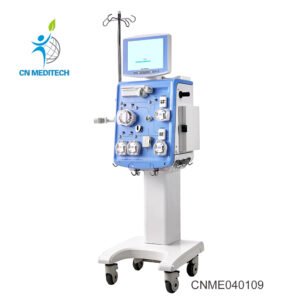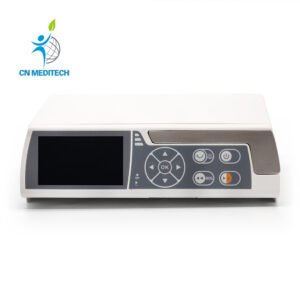What is InCenter Hemodialysis?
Center-based hemodialysis refers to hemodialysis treatment for patients with chronic kidney failure conducted in specialized medical service facilities. These facilities are typically called hemodialysis centers or hospital dialysis centers, equipped with a team of professionally certified healthcare personnel and standardized hemodialysis equipment.
Patients must follow a predetermined schedule and regularly visit the center, where trained medical staff perform, monitor, and manage the procedure using centrally installed dialysis machines. These machines carry out extracorporeal blood purification to remove accumulated metabolic waste and excess fluids from the body, thereby sustaining life.
Key Facts About Incenter Hemodialysis:
- Location: Conducted in hospitals or specially designated dialysis centers.
- Treatment frequency:Typically three times per week, each session lasting about four hours.
- Professional medical support:The entire procedure is operated and closely monitored by specialized doctors and nurses, observing the patient’s vital signs and machine parameters.
- Required equipment: Complex dialysis machines, water treatment systems, etc.
- Applicable patients:Mainly used for end-stage renal disease patients with uremia and certain acute kidney injury cases.
How is Center-Based Hemodialysis Performed?
- During center-based hemodialysis, the patient goes to a designated dialysis center.
- Medical staff first assess the patient’s condition and connect monitoring equipment.
- Using a pre-established vascular access, blood is drawn from the patient and sent through tubing into the dialysis machine.
- Inside the machine, blood passes through a filtering device, allowing toxins, excess fluid, and electrolytes to diffuse into the dialysis fluid, while beneficial substances from the dialysis fluid enter the blood. The purified blood is then returned to the patient’s body.
- Throughout the process, medical staff adjust treatment in response to the patient’s condition to ensure safety and effectiveness, and post-treatment care of the vascular access and observation follow.
Understanding the Advantages and Disadvantages of Center-Based Hemodialysis
Advantages:
- Conducted by professional medical staff in well-equipped centers, providing high safety during treatment.
- Effectively removes blood toxins and accurately regulates fluid and electrolyte balance.
- Capable of handling emergencies promptly.
- High efficiency of toxin clearance, especially suitable for severe or complex chronic renal failure patients.
- Medical team can dynamically monitor vital signs and adjust treatment plans.
- Ongoing health education and psychological support available.
Disadvantages:
- Patients must strictly follow fixed treatment times, consuming considerable time and limiting mobility.
- Repeated vascular access puncture carries risks of infection, thrombosis, or stenosis.
- Acute complications such as hypotension and muscle cramps may occur.
- Long-term dialysis can lead to cardiovascular strain, anemia, or malnutrition.
- High dependence on medical care with limited room for self-management.
Essential Equipment for Hemodialysis Centers
Hemodialysis Machine:
The core equipment of the entire dialysis treatment. Each machine serves one patient, safely circulating blood in a closed extracorporeal loop during operation.
Its core function is to precisely remove metabolic waste, excess fluid from the blood, and correct electrolyte imbalances via a unique filtration mechanism, forming the basis of a dialysis center’s operations.
The dialysis machine integrates multiple key subsystems. It includes a precise control panel for setting and adjusting treatment parameters such as blood flow rate, dialysate flow rate, temperature, conductivity, and ultrafiltration volume. A complex pump system drives the safe circulation of blood and dialysate. Multi-layered safety monitoring systems continuously detect for blood leaks, clotting, air entry in the circuit, and abnormalities in dialysate concentration or temperature, triggering alarms or stopping treatment to protect patient safety.
Dialysis Chair:
A specialized chair used by patients during dialysis treatments lasting several hours.
It emphasizes long-term comfort and adjustable treatment posture. Typically, backrest angle and leg support height can be adjusted. Armrests support patient rest, eating, or use of personal items. The chair must allow enough space on the sides for dialysis nurse to perform punctures and monitoring. Some advanced models are also equipped with heating functions.
Water Treatment System:
Water quality is critical to patient safety in dialysis; tap or regular purified water cannot be directly used. The water treatment system is essential, performing multistage purification of source water, including pre-filtration, softening, activated carbon adsorption, and reverse osmosis filtration, ultimately producing ultrapure, endotoxin-free dialysis water. This water is used to prepare dialysate and clean/disinfect dialysis machines.
Dialysis Auxiliary Equipment:
Dialysate Mixing Barrel:
A large specialized container primarily used for manual dialysate preparation in centers without centralized supply or in emergencies. Staff mix ultrapure water with dialysate A and B concentrates in strict ratios inside the barrel to create usable dialysate solution.
Central Dialysate Supply System:
A more common system in modern centers. This centralized system automatically mixes ultrapure water with dialysate concentrates and continuously delivers standardized dialysate formulas to multiple machines via pipeline networks. It improves efficiency, reduces manual mixing errors, and ensures consistent dialysate concentration.
Blood Pressure Monitoring System:
During hemodialysis, patients often experience significant blood pressure fluctuations. Continuous monitoring is vital. This system is usually connected to the dialysis machine or operated independently, automatically measuring and recording blood pressure and pulse at set intervals during treatment. Medical staff can observe trends in vital signs and promptly handle complications such as hypotension.
Infusion Pump:
During dialysis, precise drug infusion is often required—such as anticoagulants to prevent clotting in the extracorporeal circuit or saline to rapidly restore blood volume in hypotensive episodes. The infusion pump ensures accurate, continuous drug delivery at preset flow rates and dosages, ensuring medication safety and effectiveness.
Defibrillator:
Though dialysis itself is safe, patients are at higher risk of serious arrhythmias or cardiac arrest due to underlying cardiovascular diseases. A defibrillator is a core emergency device in any dialysis center, used to restore normal heart rhythm via electric shocks during ventricular fibrillation or pulseless ventricular tachycardia. It is essential in cardiopulmonary resuscitation.
Sterilization and Disinfection Equipment:
Strict disinfection is vital for infection prevention in dialysis centers. This includes physical and chemical disinfection methods. Common devices include large cleaning and sterilizing machines and sterilizers for thoroughly cleaning and disinfecting reusable medical instruments. Small devices for surface disinfection are also used to ensure sterile or high-level disinfected medical tools, protecting patient safety.
Frequently Asked Questions
What is the difference between peritoneal dialysis and hemodialysis?
The key difference lies in waste/fluid removal method, location, and operation. Peritoneal dialysis uses the patient’s own peritoneum as a membrane and can be done at home or during daily activities with simpler procedures. Hemodialysis requires extracorporeal machines and artificial filters operated by trained professionals in centers or at home after training.
Choose a dialysis center or home dialysis?
This depends on overall health condition, home environment, physical ability, willingness and capacity to operate equipment, and support systems. Each option has its benefits:
Advantages of Hemodialysis at Home:
- More convenient:Allows flexible, self-controlled scheduling.
- Improved quality of life:Reduces dependency on others and integrates naturally into daily life.
- Less travel:Saves time and reduces travel burden, especially beneficial for those with mobility issues.
Advantages of Incenter Hemodialysis:
- Professional support:Medical staff supervise the entire procedure and ensure safety.
- Better emergency response:Well-equipped for timely management of complications.
- No burden of equipment operation or maintenance: No need to manage cleaning or disinfection at home.





